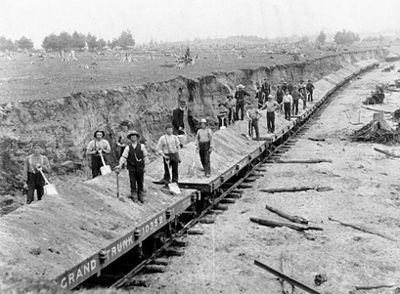The strike that began on 14 February 1949 in Asbestos, Quebec, is one of those events that resonate beyond the immediate and define history. It was, as Pierre Trudeau later wrote, “a violent announcement that a new era had begun.”
Context
At the time of the strike, Premier Maurice Duplessis and his Union Nationale party had a choke hold on the province of Quebec. Called “le Chef,” he saw himself as a patriarch and the citizens as his children. Those who supported him received his blessings in the form of patronage; those who opposed him were ignored or punished. Whenever he went too far, he had a gift for redeeming himself with a great speech or gesture. Above all he had mastered the fine Canadian art of rallying provincial support by reviling the federal government in Ottawa.

One thing that Duplessis could not stand was change, and the events that were about to unfold in the obscure mining town of Asbestos would be the first serious threat to his hegemony.
In December 1948, negotiations began on a labour contract for 1949. The miners’ demands included a wage of $1 per hour, nine paid holidays, union participation in the management of the mines, a pension and company action to protect workers against illnesses caused by exposure to asbestos. The negotiations hit a deadlock by early February. By law, both sides were required to go to arbitration. This was a happy prospect for the company, for the government tended to chose pro-business arbitrators.
Strike
The dispute attracted a large group of activists from Montreal, who came to support the workers. Among them was union militant Jean Marchand, whose fiery speech to the workers on 13 February 1949 incited their cries of “On with the strike!” In the early days of the strike, there was almost a holiday atmosphere as people strolled about. Fiddlers and accordion players provided music.

It did not take long for the premier to respond. Within days, his government declared the strike illegal and dispatched a battalion of provincial police. For about a month the strikers remained calm, but since Quebec supplied 85 per cent of the world’s asbestos, the American-owned Johns-Manville Company grew restive and began to hire replacement workers. The police began active patrols and threatened the miners. The workers set up roadblocks to keep out the “scabs.” On 14 March, there was an explosion on the railway track leading into the plant. A few days later, a group of strikers abducted and beat a company official.
At the mill, the police assembled to break the picket lines. They attacked the strikers with tear gas and fired warning shots into the air. The strikers dragged police from their cars and beat them unconscious. On the morning of 6 May, a heavily armed police force entered the town, arrested about 180 strikers and battered several of them. Now the brutality of the provincial police became the central issue and drew media attention from beyond Quebec.
Duplessis railed against the union leaders, calling them “saboteurs” and “subversive agents.” But even the conservative Catholic Church found itself in sympathy with the strikers; it raised most of the support for the families struggling from weeks of lost wages. When the Archbishop of Montreal, Joseph Charbonneau, openly championed the strike, Duplessis appears to have successfully encouraged the Vatican to order his resignation and transfer to British Columbia. Archbishop Maurice Roy of Quebec City mediated the strike through the spring. An agreement was finally reached on 1 July.
Importance
The strike continued to play an important role in the minds of Quebec intellectuals in the years leading up to the Quiet Revolution. It led many to question the kind of nationalism that buttressed the conservative and anti-labour Duplessis government. It also provided the first stage for several intellectuals, namely Trudeau, Marchand and Gérard Pelletier. The “Three Wise Men,” as they later became known, would play profound roles in the political developments not only of Quebec but of Canada.
For the workers, back to work in the dangerous air of the asbestos mines, the strike was no revolution. Their material gains were small. Many were not rehired, and little was done to alleviate the working conditions that would take many lives over the next generation. In 1974, Dr. Irving J. Selikoff, the world’s foremost authority on asbestos-related diseases, described the asbestos mining towns of Quebec as the most dangerous in the world. (See also Mining Safety and Health.)

The bitterness of the strike lingered for decades in the town of Asbestos. In 2003, André Bachand, Member of Parliament for Richmond–Arthabaska, said in the House of Commons: “Still today, when a scab passes away, the only people at the funeral home are the priest and a few members of the Knights of Columbus to pray for his soul.”

 Share on Facebook
Share on Facebook Share on X
Share on X Share by Email
Share by Email Share on Google Classroom
Share on Google Classroom








